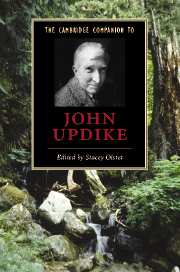Book contents
- Frontmatter
- Introduction: “A sort of helplessly 50’s guy”
- Part I Early influences and recurrent concerns
- 1 Updike, middles, and the spell of “subjective geography”
- 2 “Nakedness” or realism in Updike’s early short stories
- 3 Updike, religion, and the novel of moral debate
- Part II Controversy and difference
- Part III American chronicles
- Conclusion: U(pdike) & P(ostmodernism)
- Select bibliography
- Index
3 - Updike, religion, and the novel of moral debate
from Part I - Early influences and recurrent concerns
Published online by Cambridge University Press: 28 August 2006
- Frontmatter
- Introduction: “A sort of helplessly 50’s guy”
- Part I Early influences and recurrent concerns
- 1 Updike, middles, and the spell of “subjective geography”
- 2 “Nakedness” or realism in Updike’s early short stories
- 3 Updike, religion, and the novel of moral debate
- Part II Controversy and difference
- Part III American chronicles
- Conclusion: U(pdike) & P(ostmodernism)
- Select bibliography
- Index
Summary
In early 1958, John Updike, flush from the publication of his first poetry collection and the completion of his first novel, The Poorhouse Fair, moved his growing family out of New York City and into a seventeenth-century clapboard house in Ipswich, Massachusetts, where, by his own account, he suffered a full-blown existential crisis, one that had actually been brewing for several years. “Amid my new responsibilities,” he has explained, “I felt fearful and desolate, foreseeing, young as I was, that I would die, and that the substance of the earth was, therefore, death” (Odd, 844). Two books saved him from this abyss: Fear and Trembling (1843) by the Danish existentialist writer Søren Kierkegaard (1813-55) and The Word of God and the Word of Man (1928) by the twentieth-century German theologian Karl Barth (1886-1968). “[F]or a while,” he recently wrote, “I read both theological thinkers greedily, but it was these two titles, I suppose, that gave me a philosophy to live and labor by, and in that way changed my life” (More, 843).
What both writers share is a dialectical approach to religious issues in which defining oppositions do not resolve into a satisfying synthesis but rather remain in sustained tension and ambiguity, a philosophical and theological standpoint that Updike quickly seized upon as consistent with his own attempt to treat religious matters in fiction in such a way as to avoid the sort of all-encompassing generalizations that would otherwise destroy the delicate particularizing that literature demands. As such, Kierkegaard and Barth did more than help Updike recover his faith; they also provided him with a model for his own theological and aesthetic vision.
- Type
- Chapter
- Information
- The Cambridge Companion to John Updike , pp. 43 - 58Publisher: Cambridge University PressPrint publication year: 2006
- 1
- Cited by



